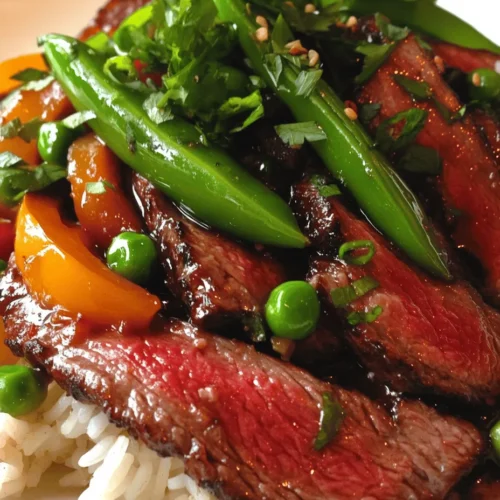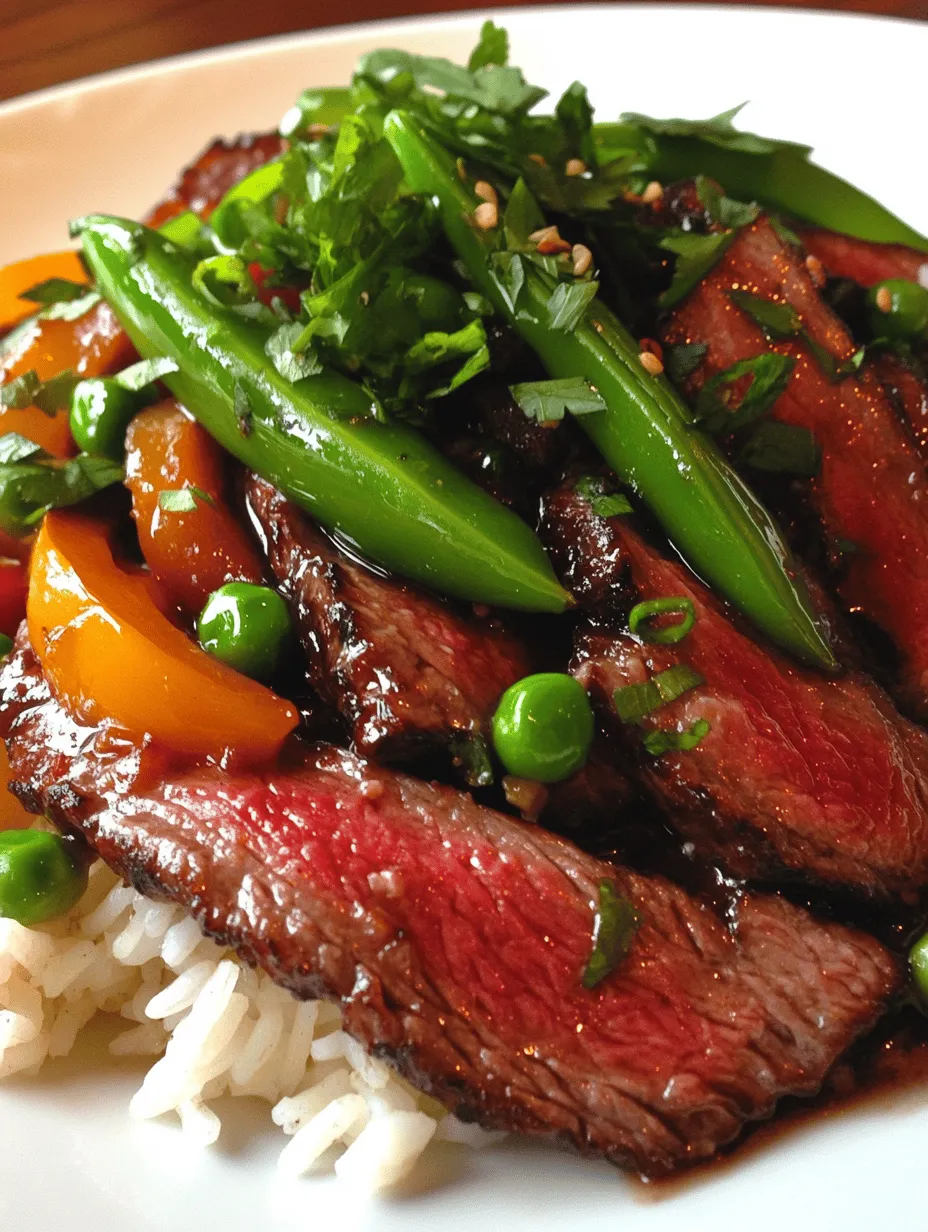Introduction
Savory Beef with Oyster Sauce is a delightful dish that brings the comforting warmth of Asian cuisine right to your kitchen. It’s a quick, delicious stir-fry option that appeals to both novice cooks and seasoned chefs. Whether you are pressed for time on a weeknight or looking to impress guests at a dinner party, this recipe stands out due to its vibrant flavors and effortless preparation.
Originating from the rich culinary traditions of East Asia, this dish showcases the harmonious balance of sweet, salty, and umami flavors. The use of oyster sauce, a staple in many Asian kitchens, elevates the dish and adds a distinctive depth that is hard to resist. The versatility of Savory Beef with Oyster Sauce also allows it to be paired with a variety of sides, making it an ideal choice for any meal. Serve it over a bed of fluffy rice or mix it with noodles for an even heartier option.
This dish is not only about taste; it also embodies the art of stir-frying—a cooking technique that emphasizes speed and high heat to lock in the freshness and nutrients of the ingredients. As you navigate through this recipe, you will discover the simplicity of the cooking process, making it a favorite for busy households while still delivering an impressive culinary experience.
Understanding the Ingredients
To create a truly memorable Savory Beef with Oyster Sauce, it’s crucial to understand the key components that make this dish shine. Each ingredient plays a significant role in crafting the flavor profile and texture of the final dish.
Flank Steak
Flank steak is a popular choice for stir-frying due to its unique texture and robust flavor. This cut of beef is lean but still tender, making it ideal for quick cooking methods. When sliced thinly against the grain, flank steak absorbs marinades beautifully and develops a satisfying chewiness that complements the dish’s overall texture. Its bold flavor serves as a perfect canvas for the savory sauces and aromatics that accompany it.
Oyster Sauce
Oyster sauce is the star of this dish. It is a thick, dark sauce made from oyster extracts, sugar, salt, and water, and it holds a prominent place in Asian cooking. The sauce contributes an unparalleled umami flavor that enhances the savory notes of the beef. Its slightly sweet and salty profile rounds out the dish, making it incredibly addictive. Besides flavor, oyster sauce also adds a glossy finish to the stir-fry, making it visually appealing.
Soy Sauce
Another essential ingredient in this recipe is soy sauce. This fermented condiment is ubiquitous in Asian cuisine and adds a salty, savory depth that complements the sweetness of the oyster sauce. Soy sauce works synergistically with oyster sauce, enhancing the overall flavor complexity of the dish. It also contributes to the beautiful brown color of the stir-fry, making it more appetizing.
Cornstarch
Cornstarch serves multiple purposes in this recipe. Primarily, it acts as a tenderizer for the beef, helping to break down muscle fibers and creating an incredibly tender bite. When mixed with the marinade, cornstarch creates a light coating on the beef that facilitates an even sear during cooking. This coating also helps to lock in moisture, ensuring that the meat remains juicy and flavorful throughout the cooking process.
Vegetable Oil
For stir-frying, vegetable oil is the preferred choice due to its high smoke point. This characteristic allows the oil to reach the necessary temperatures needed for quick cooking without burning. When heated, vegetable oil creates a non-stick surface that ensures the beef and vegetables can sear beautifully, developing those coveted brown bits that add flavor to the dish.
Aromatics
No stir-fry would be complete without aromatics, and in this recipe, garlic and ginger play a pivotal role. Fresh garlic adds a pungent, savory note, while ginger infuses warmth and a hint of spice. Together, they create a fragrant base that enhances the overall flavor profile of the dish. The key to unlocking their flavors is to sauté them briefly in hot oil until they become fragrant, ensuring that their essence is released into the stir-fry.
Vegetables
The choice of vegetables can greatly enhance the dish’s color, texture, and nutritional value. For this recipe, bell peppers, snap peas, and onions offer a vibrant mix. Bell peppers provide a sweet crunch, snap peas add crispness and a pop of green, while onions contribute sweetness and depth. This combination not only makes the dish visually appealing but also adds a variety of textures that elevate the overall eating experience.
Preparation Steps
Now that you have a solid understanding of the key ingredients, let’s delve into the preparation process for Savory Beef with Oyster Sauce. This section will guide you through the important steps to ensure that your dish turns out perfectly every time.
Marinating the Beef
Marinating the beef is a crucial step that significantly impacts the flavor and tenderness of your dish. To start, thinly slice the flank steak against the grain into strips about 1/4 inch thick. This technique helps to break down the fibers and ensures that each bite is tender. Once sliced, place the beef in a bowl and add a mixture of oyster sauce, soy sauce, and cornstarch.
The ideal marinating time is about 15-30 minutes. This duration allows the meat to absorb the flavors of the marinade while the cornstarch begins to tenderize it. For a deeper flavor, you can marinate the beef for up to an hour, but be cautious not to exceed this time, as the acidity in the sauces can begin to break down the meat too much, resulting in a mushy texture.
Preparing the Vegetables
While the beef is marinating, you can prepare the vegetables. Efficient preparation is key to a successful stir-fry, as you want everything to be ready to go when it’s time to cook. Start by washing the bell peppers and snap peas thoroughly. Cut the bell peppers into thin strips, making sure to remove the seeds and white pith for a cleaner taste.
For the snap peas, simply trim the ends, as they can be added whole to the stir-fry for a delightful crunch. Slice the onion into thin wedges or rings, depending on your preference. It’s important to have all the vegetables prepared and within reach, as stir-frying requires quick cooking and constant attention. Having everything prepped in advance will help you avoid overcooking and ensure that your vegetables maintain their freshness and vibrant color.
Cooking Techniques
With your ingredients prepped and marinated, it’s time to explore the cooking techniques involved in making Savory Beef with Oyster Sauce. Mastering these techniques will not only enhance your dish but also improve your overall stir-frying skills.
Begin by heating a large skillet or wok over medium-high heat. Add a generous amount of vegetable oil, enough to coat the bottom of the pan. Allow the oil to heat until it shimmers, signaling that it is hot enough for cooking. It’s essential to ensure the oil is adequately heated, as this will prevent the food from steaming and instead promote the desired searing effect.
Once the oil is hot, add the marinated beef to the pan in a single layer. It’s important not to overcrowd the pan, as this can lower the temperature and lead to steaming rather than frying. Cook the beef for about 2-3 minutes, allowing it to sear and develop a rich brown color. Use a spatula to stir the beef occasionally, ensuring even cooking.
After the beef is nearly cooked through, add the garlic and ginger to the pan, stirring quickly to combine. This is where the aromatics will begin to release their enticing fragrances. Following this, introduce the prepared vegetables to the pan. Stir-fry everything together for an additional 2-3 minutes, allowing the vegetables to become tender yet still crisp.
Finally, pour in any remaining marinade and toss everything together for another minute, allowing the sauce to coat the beef and vegetables evenly. This final step will enhance the dish’s flavor, creating a glossy finish that is irresistible.
In the next section of this article, we will dive deeper into the final touches and presentation of Savory Beef with Oyster Sauce, ensuring you can serve this dish with flair and confidence. Stay tuned for tips on how to make this dish your own and answer any lingering questions you may have about this delightful stir-fry!

Heating the Pan
Achieving the perfect sear on beef is an art that begins with temperature control. Start by heating your skillet or wok over medium-high heat for several minutes. This step is crucial because a hot pan allows the beef to caramelize properly, resulting in a beautifully browned exterior that enhances flavor. If your pan isn’t hot enough, the beef will stew instead of sear, leading to a less appealing texture and taste.
To test if the pan is ready, sprinkle a few drops of water onto the surface. If they sizzle and evaporate almost immediately, you’re good to go. For the best results, use a high smoke point oil, such as vegetable or canola oil, to prevent burning while stir-frying. Once the oil shimmers, you can proceed to cook the beef.
Cooking the Beef
When cooking stir-fried dishes, particularly one featuring beef, timing and technique are everything. Slice the beef against the grain into thin strips, ensuring even cooking. When adding the beef to the hot pan, do not overcrowd it. Cooking in batches allows for better browning and prevents steaming.
Stir-fry the beef for about 2-3 minutes, tossing it frequently until it turns brown and is just cooked through. The key to knowing when the beef is perfectly cooked lies in its color and texture. It should be browned on the outside and slightly pink on the inside. Overcooking can lead to tough, chewy beef, which is not what you want for this dish. Once the beef is cooked to perfection, remove it from the pan and set it aside, allowing the residual heat to finish the cooking process.
Stir-Frying Vegetables
Next, it’s time to turn your attention to the vegetables. Maintaining their crispness while ensuring they are thoroughly cooked is crucial for a stir-fry’s success. Begin with the vegetables that take longer to cook, such as bell peppers and onions, and add them to the pan in batches. Stir-fry them for about 1-2 minutes, allowing them to soften slightly without losing their vibrant color and crunch.
Add the snap peas last, as they require less time to cook—about 1 minute should suffice. This technique ensures a delightful variety of textures in your dish. To keep vegetables crisp, consider using a splash of water or broth towards the end of cooking. This method creates steam that can help finish cooking without compromising their texture.
Combining Ingredients for Maximum Flavor
With the beef and vegetables cooked, it’s time to bring everything together. Add the beef back into the pan along with any juices that have accumulated on the plate. This step is essential for maximizing flavor, as it allows the beef to mingle with the vegetables and absorb their delicious essence.
Pour in the oyster sauce, which acts as the central flavor component of this dish. Stir everything together, ensuring that the sauce evenly coats the beef and vegetables. The combination of savory oyster sauce and the natural sweetness of the vegetables creates a delightful balance. Taste the mixture at this stage, adjusting the seasoning as needed. If you prefer a slight kick, consider adding a sprinkle of crushed red pepper or a dash of soy sauce for an extra umami boost.
Adding Seasoning
Timing is everything when it comes to seasoning. As you combine the ingredients, now is the perfect moment to add salt and pepper. Begin with a light hand; you can always add more, but it’s challenging to counteract over-seasoning. Stir well to ensure the seasoning is evenly distributed. Remember, the oyster sauce already has a salty profile, so adjust accordingly to maintain balance.
The Role of Sesame Oil
Just before serving, drizzle a small amount of toasted sesame oil over the stir-fry. This addition is crucial as it amplifies the dish’s aroma and adds a nutty depth of flavor that elevates the overall profile. A little goes a long way, so aim for about a teaspoon—too much can overwhelm the other flavors.
Serving Suggestions
Presentation is key when serving Savory Beef with Oyster Sauce. Begin by preparing a bed of fluffy jasmine rice, which enhances the dish’s overall flavor and texture. The fragrant, slightly sticky rice pairs beautifully with the savory beef, making each bite delightful.
To serve, spoon the beef and vegetable mixture generously over the jasmine rice. For an eye-catching finish, garnish with finely sliced green onions. The green onions not only add a pop of color but also a fresh, mild onion flavor that complements the richness of the dish.
Nutritional Benefits
Savory Beef with Oyster Sauce is not only delicious but also nutritious. The lean beef provides a robust source of protein, essential for muscle repair and growth. Including protein in your meals helps keep you feeling full and satisfied longer, making it an excellent choice for a balanced diet.
The variety of vegetables in this dish also contributes valuable nutrients. Bell peppers are rich in vitamins A and C, which are known for their antioxidant properties. Snap peas add fiber, vitamins K and C, and iron to the mix, while onions provide quercetin, a powerful antioxidant. When served with jasmine rice, this meal becomes a well-rounded option, offering a balance of protein, carbohydrates, and essential vitamins.
Conclusion
Savory Beef with Oyster Sauce is a delightful blend of flavors and textures that showcases the beauty of stir-frying. With its ease of preparation and the ability to adapt based on your preferences, it’s a dish that can be enjoyed by everyone. Whether you’re cooking for family or entertaining guests, this meal is sure to impress.
Encouraging readers to try making this dish at home is essential; the joy of creating a flavorful meal is an experience everyone should have. With just a few simple ingredients and techniques, you can whip up a restaurant-quality meal in the comfort of your kitchen. So gather your ingredients and embark on this culinary adventure—you won’t be disappointed!



